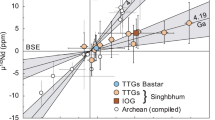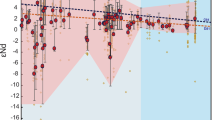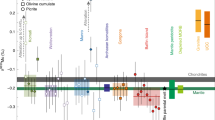Abstract
THE episodic extraction of juvenile continental crust from the Earth's mantle over the past 4 Gyr has led to a progressive depletion of incompatible elements in the upper mantle1,2. A knowledge of the degree and uniformity of this mantle depletion throughout Earth history is important for understanding the growth of continents, the evolution of the crust-mantle system and the nature of mantle convection through time. Here we report initial 143Nd/144Nd ratios, for 1.8-Gyr-old mafic volcanics from the Harts Range meta-igneous complex of central Australia which are the highest yet reported for Proterozoic igneous rocks (ɛNd = +6.9 to +8.2 for the least contaminated samples). These ratios far exceed those proposed in models3–5 for the isotopic evolution of the depleted mantle at this time, and imply the existence of a mantle reservoir that had been highly depleted for at least 1 Gyr. This provides strong evidence that major periods of continental growth, such as that in the late Archaean, produced long-lived heterogeneities in the upper mantle.
This is a preview of subscription content, access via your institution
Access options
Subscribe to this journal
Receive 51 print issues and online access
$199.00 per year
only $3.90 per issue
Buy this article
- Purchase on Springer Link
- Instant access to full article PDF
Prices may be subject to local taxes which are calculated during checkout
Similar content being viewed by others
References
Allègre, C. J. Earth planet. Sci. Lett. 86, 175–203 (1987).
McCulloch, M. T. & Bennett, V. C. Geochim. cosmochim. Acta (submitted).
De Paolo, D. J. Nature 291, 193–196 (1981)
McCulloch, M. T. & Compston, W. Nature 294, 322–327 (1981).
Galer, S. J. G., Goldstein, S. L. & O'Nions, R. K. Chem. Geol. 75, 257–290 (1989).
Sivell, W. J. & Foden, J. D. Precambr. Res. 28, 223–252 (1985).
Sivell, W. J., Foden, J. D. & Lawrence, R. W. Austr. J. Earth Sci. 32, 449–465 (1986).
Ding, P. & James, P. R. Precambr. Res. 27, 251–276 (1985).
James, P. R. & Ding, P. Precambr. Res. 40/1, 199–216 (1988).
Cooper, J. A., Mortimer, G. E. & James, P. R. Precambr. Res. 40/1, 217–231 (1988).
Nelson, B. K. & De Paolo, D. J. Nature 312, 143–146 (1984).
Patchett, P. J. & Bridgwater, D. Contrib. Miner. Petrol. 87, 311–318 (1984).
Patchett, P. J. & Kuovo, O. Contrib. Miner. Petrol. 92, 1–12 (1986).
Chauvel, C., Arndt, N. T., Kielinzcuk, S. & Thom, A. Can. J. Earth Sci. 24, 396–406 (1987).
McCulloch, M. T. & Gamble, J. A. Earth planet. Sci. Lett. 102, 358–374 (1991).
De Paolo, D. J. & Wasserburg, G. J. Geophys. Res. Lett. 3, 249–252 (1976).
Collerson, K. D., Campbell, L. M., Weaver, B. L. & Palacz, Z. A. Nature 349, 209–214 (1991).
Chauvel, C., Dupré, B. & Jenner, G. A. Earth planet. Sci. Lett. 74, 315–324 (1985).
Sun, S. S., Nesbitt, R. W. & Sharaskin, A. Ya. Earth planet. Sci. Lett. 44, 119–138 (1979).
Sun, S. S. & McDonough, W. F. Geol. Soc. Spec. Publ. 42, 313–345 (1989).
Volpe, A. M., Macdougall, J. D. & Hawkins, J. W. Earth planet. Sci. Lett. 82, 241–254 (1987).
Ikeda, Y. & Yuasa, M. Contrib. Miner. Petrol. 101, 377–393 (1989).
Volpe, A. M., Macdougall, J. D. & Hawkins, J. W. Earth planet Sci. Lett. 90, 174–186 (1988).
Sivell, W. J. & Foden, J. D. Precambr. Res. 38, 235–255 (1988).
Foden, J. D., Buick, I. S. & Mortimer, G. E. Precambr. Res. 40/1, 233–259 (1988).
Ewart, A. & Hawkesworth, C. J. J. Petrol. 28, 495–530 (1987).
McCulloch, M. T. in Precambrian Lithospheric Evolution (American Geophysical Union, Washington, DC, 1987).
McCulloch, M. T. & Chappell, B. W. Earth planet Sci. Lett. 58, 51–64 (1982).
Jacobsen, S. B. & Wasserburg, G. J. Earth planet Sci. Lett. 50, 139–155 (1980).
Huhma, H. Terra Cogn. 4, 192 (1984).
Gruau, G., Martin, H., Leveque, B., Capdevela, R. & Marot, A. Precambr. Res. 30, 63–80 (1985).
Author information
Authors and Affiliations
Rights and permissions
About this article
Cite this article
Sivell, W., McCulloch, M. Neodymium isotope evidence for ultra-depleted mantle in the early Proterozoic. Nature 354, 384–387 (1991). https://doi.org/10.1038/354384a0
Received:
Accepted:
Issue Date:
DOI: https://doi.org/10.1038/354384a0
Comments
By submitting a comment you agree to abide by our Terms and Community Guidelines. If you find something abusive or that does not comply with our terms or guidelines please flag it as inappropriate.



